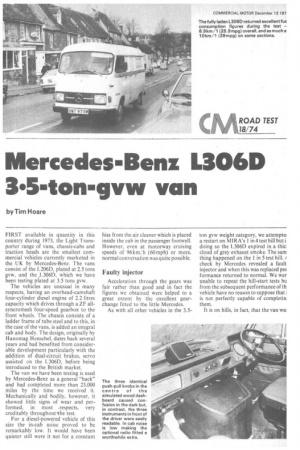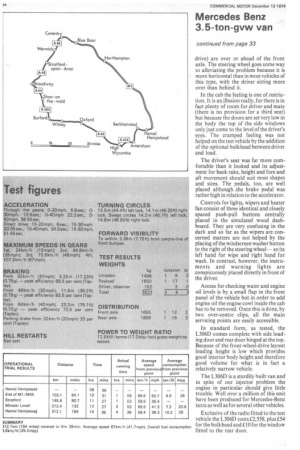Mercedes-Benz L3060 3•5-ton-gvw van
Page 34

Page 35

Page 36

If you've noticed an error in this article please click here to report it so we can fix it.
by Tim Hoare
FIRST available in quantity in this country during 1973, the Light Transporter range of vans, chassis-cabs and traction heads are the smallest commercial vehicles currently marketed in the UK by Mercedes-Benz. The vans consist of the L206D, plated at 2.5 tons gvw, and the ,L306D, which we have been testing plated at 3.5 tons gvw.
The vehicles are unusual in many respects, having an overhead-camshaft four-cylinder diesel engine of 2.2 litres capacity which drives through a ZF allsyncromesh four-speed gearbox to the front wheels. The chassis consists of a ladder frame of tube steel and to this, in the case of the vans, is added an integral cab and body. The design, originally by Hanornag Henschel, dates back several years and had benefited from considerable development particularly with the addition of dual-circuit brakes, servo assisted on the L306D, before being introduced to the British market.
The van we have been testing is used by Mercedes-Benz as a general "hack" and had completed more than 23,000 miles by the time we received it. Mechanically and bodily, however, it showed little signs of wear and performed, in most respects, very creditably throughout he test.
For a diesel-powered vehicle of this size the in-cab noise proved to be remarkably low. It would have been quieter still were it not for a constant hiss from the air cleaner which is placed inside the cab in the passenger footwell. However, even at motorway cruising speeds of 96km/ h (60 mph) or more, normal conversation was quite possible.
Faulty injector
Acceleration through the gears was fair rather than good and in fact the figures we obtained were helped to a great extent by the excellent gearchange fitted to the little Mercedes.
As with all other vehicles in the 3.5
ton gvw weight category, we attempte, a restart on MIRA's I in 4 test hill but i doing so the L306D expired in a thic' cloud of grey exhaust smoke. The sam thing happened on the 1 in 5 test hill. check by Mercedes revealed a fault• injector and when this was replaced per formance returned to normal. We wer unable to repeat the hill-start tests bu from the subsequent performance of th vehicle have no reason to suppose that i is not perfectly capable of completin them.
It is on hills, in fact, that the van wa!
at its most disappointing. Although one wonld not expect a vehicle of this size and type to need five gears, they certainly seem to be necessary in this case. The gap between second and third, in particular, is too wide for the torque characteristics of the engine, with the result that on many hills on our test route the van would storm up at its maximum governed speed in second but changing up into third just resulted in a rapid falling off in speed.
Overall performance, however, proved to be very satisfactory and full use could be made of the 50mph speed limit on normal roads which now applies to vehicles under 30 cwt unladen. Fuel consumptiOn in particular was good, 9.9 km (28 mpg) being recorded on the 64.1 miles of MI/ M45 used for the motorway section of the test. Overall consumption, fully laden, for the complete 194 miles was 8.9 km/ I (25. 2 mpg), A locking front offside brake caused swerving to the left during the crash stop tests from 64 km/ h (40mph) and this also resulted in poor deceleration from this speed. This fault, howevcr, was not noticeable under normal braking conditions and in fact the brakes felt most progressive, if somewhat heavy, throughout the test. The handbrake held the vehicle on the 1 in 4 hill in both directions.
Sturdy construction
The many rough parts of the route presented few problems and served to emphasize the obvious sturdiness in .construction of both .chassis and body. Both roll and pitch were quite minimal and for the driver the ride was surprisingly good in view of his position immediately over the front wheels.
The steering of these vehicles seems to be particularly heavy (a nuisance in confined spaces) which is not surprising perhaps since all the main mechanical components (engine, gearbox and final drive) are over or ahead of the front axle. The steering wheel goes some way to alleviating the problem because it is more horizontal than in most vehicles of this type, with the driver sitting more over than behind it.
In the cab the feeling is one of restriction. It is an illusion really, for there is in fact plenty of room for driver and mate (there is no provision for a third seat) but because the doors are set very low in the body the top of the side windows only just come to the level of the driver's eyes. The cramped feeling was not helped on the test vehicle by the addition of the optional bulkhead between driver and load.
The driver's seat was far more comfortable than it looked and its adjustment for back rake, height and fore and aft movement should suit most shapes and sizes. The pedals, too, are well placed although the brake pedal was rather high in relation to the accelerator.
Controls for lights, wipers and heater fan consist of three identical and closely spaced push-pull buttons centrally placed in the simulated wood dashboard. They are very confusing in the dark and so far as the wipers are concerned matters are not helped by the placing of the windscreen washer button to the right of the steering wheel so its left hand for wipe and right hand for wash. In contrast, however, the instruments and warning lights are conspicuously placed directly in front of the driver.
Access for checking water and engine oil levels is by, a small flap in the front panel of the vehicle but in order to add engine oil the engine cowl inside the cab has to be removed. Once this is done, by two over-centre clips, all the main servicing points are easily accessible.
In standard form, as tested, the L306D comes complete with side loading door and rear door hinged at the top. Because of the front-wheel-drive layout loading height is low which provides good interior body height and therefore good volume for what is in fact a relatively narrow vehicle.
The L 306D is a sturdily built van and in spite of our injector problem the engine in particular should give little trouble. Well over a million of this unit have been produced for Mercedes-Benz taxis as well as for several other vehicles.
36.3 10.2 29
Exclusive of the radio fitted to the test vehicle the L 306D costs £2,558, plus £54 Overall fuel consumption for the bulkhead and £10 for the window fitted to the rear door.




























































































